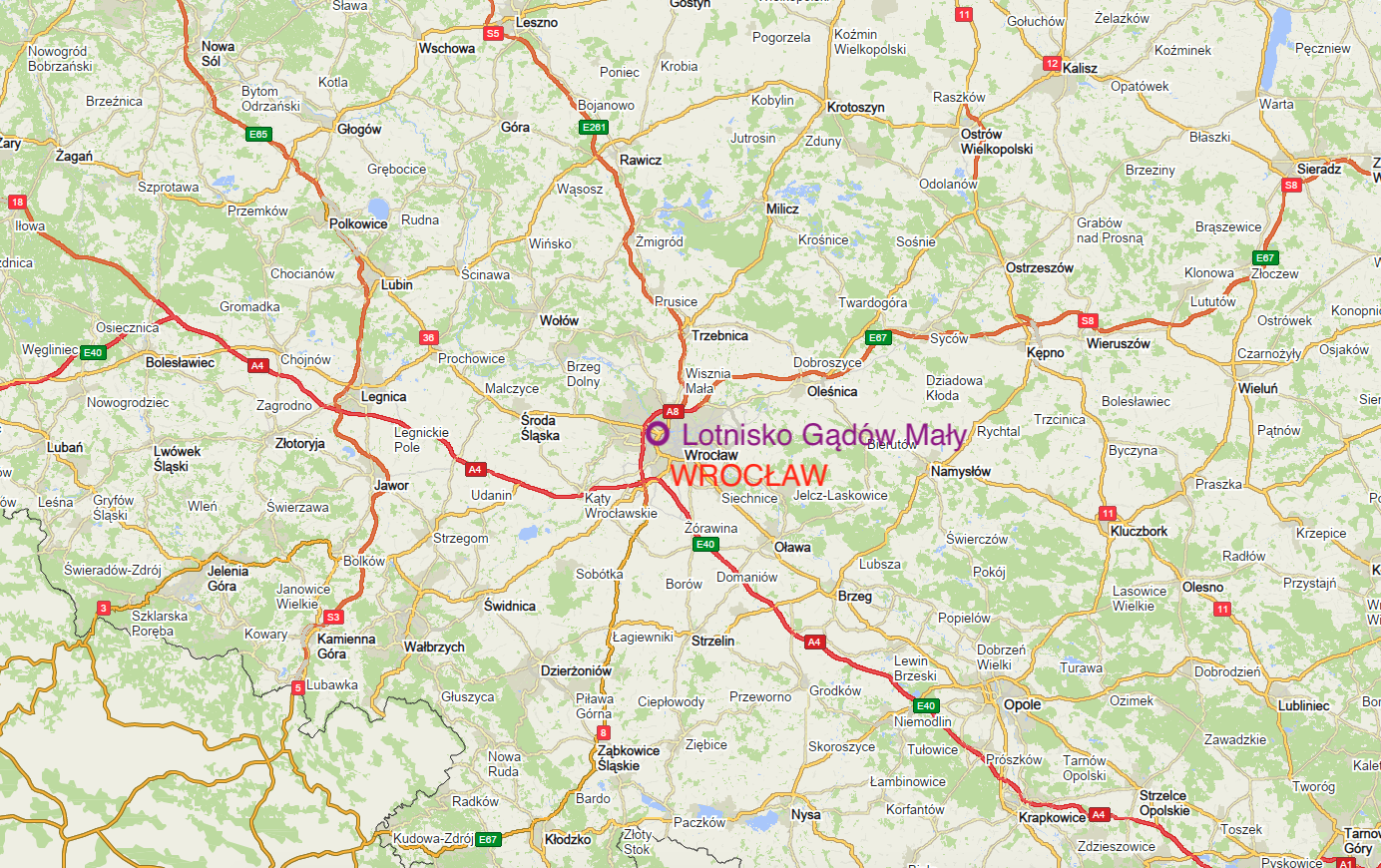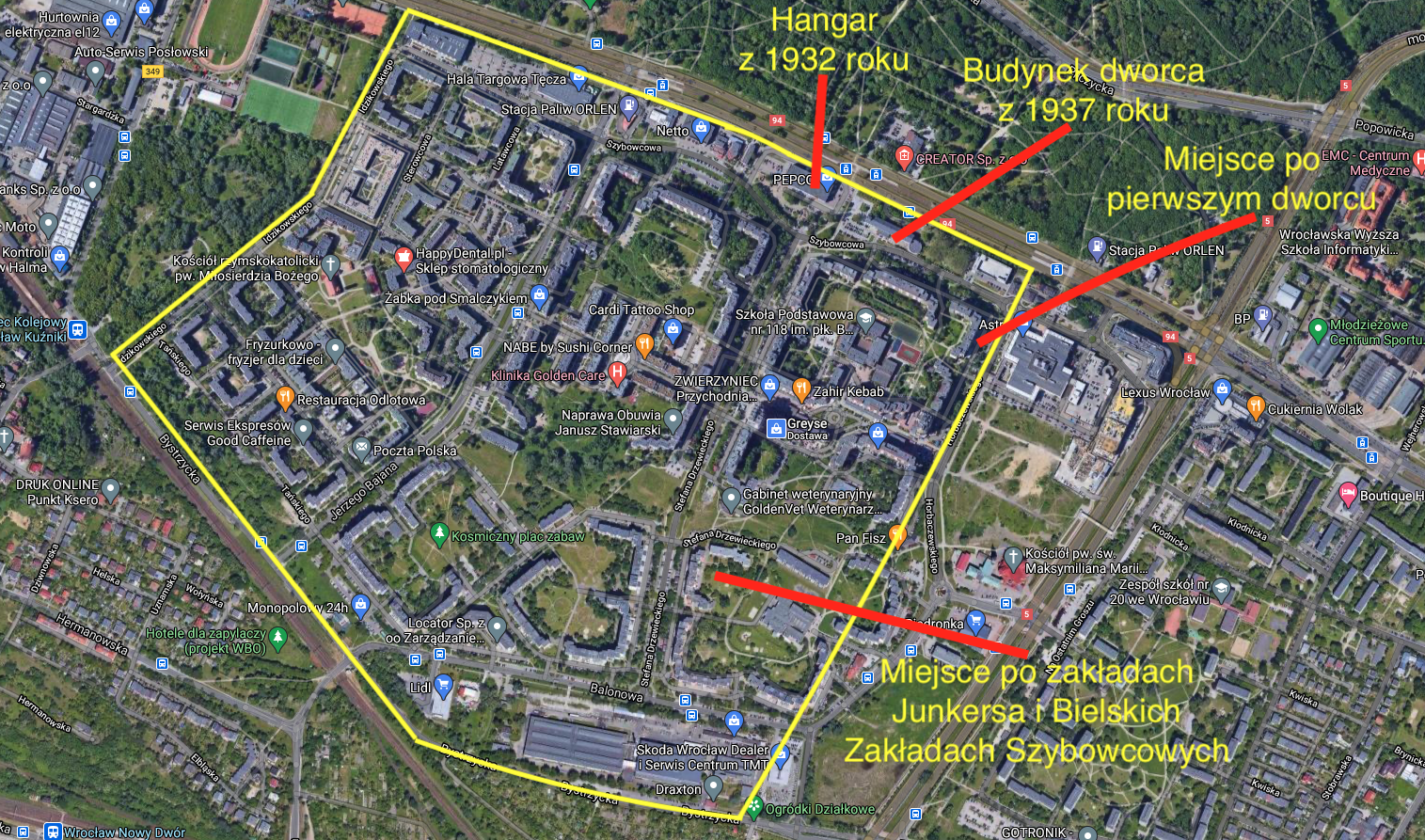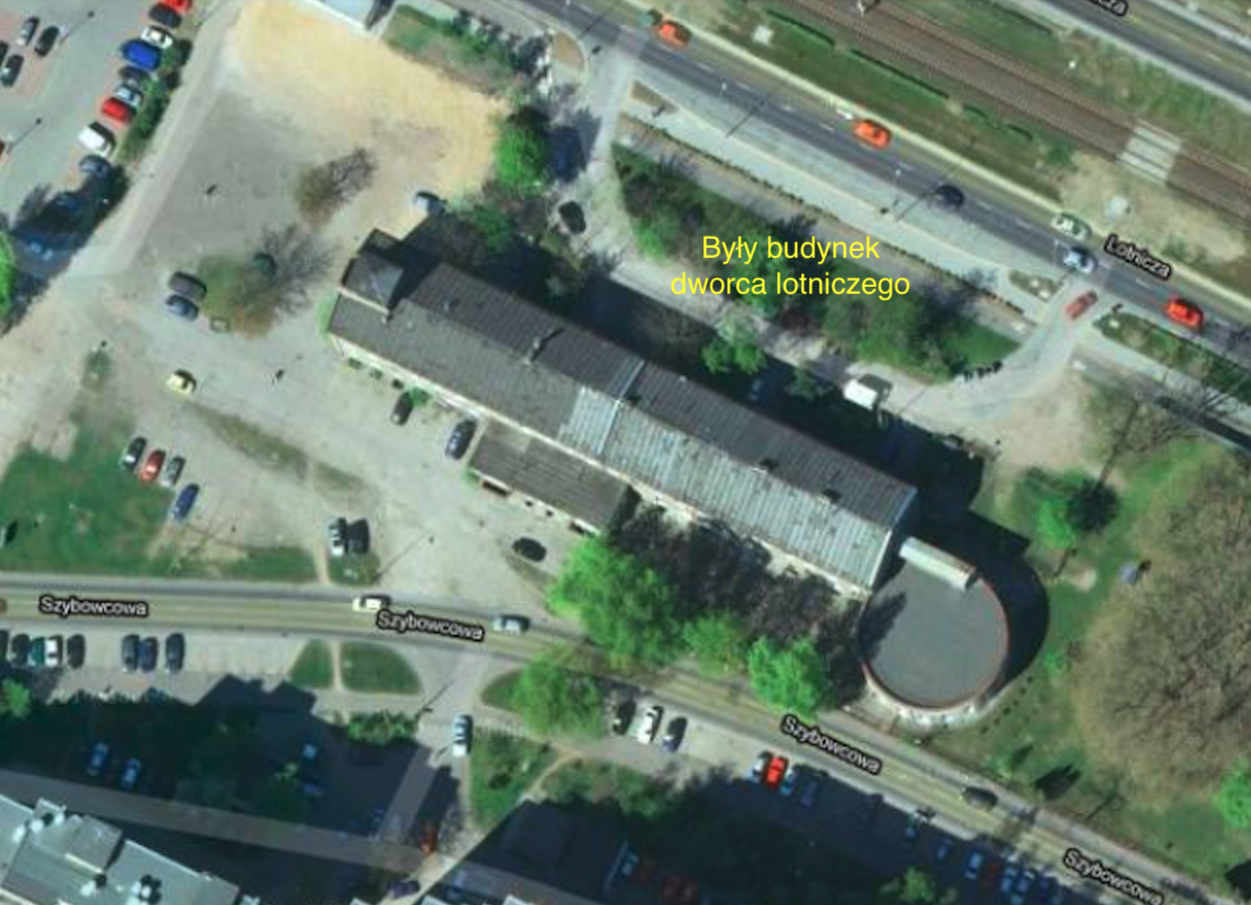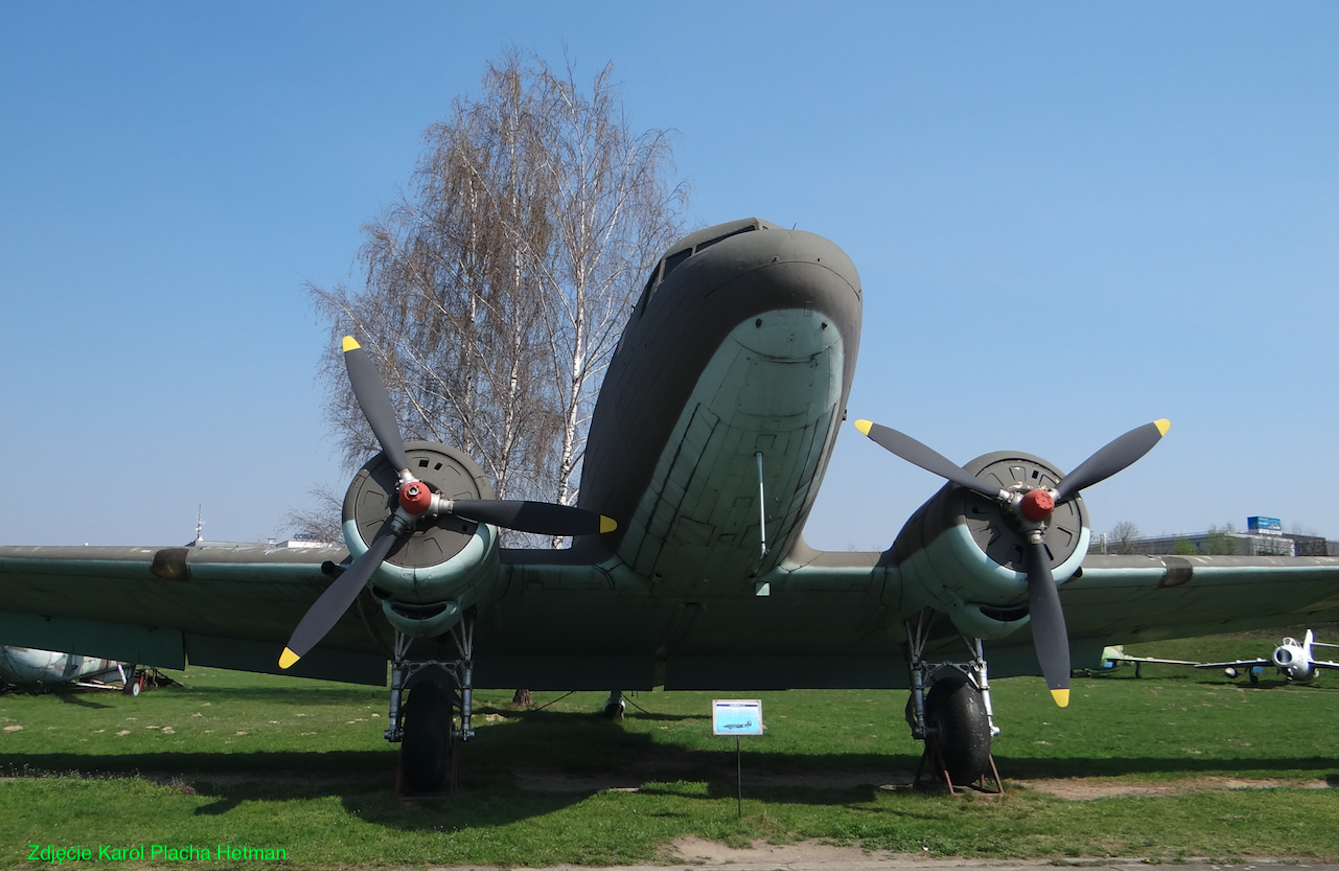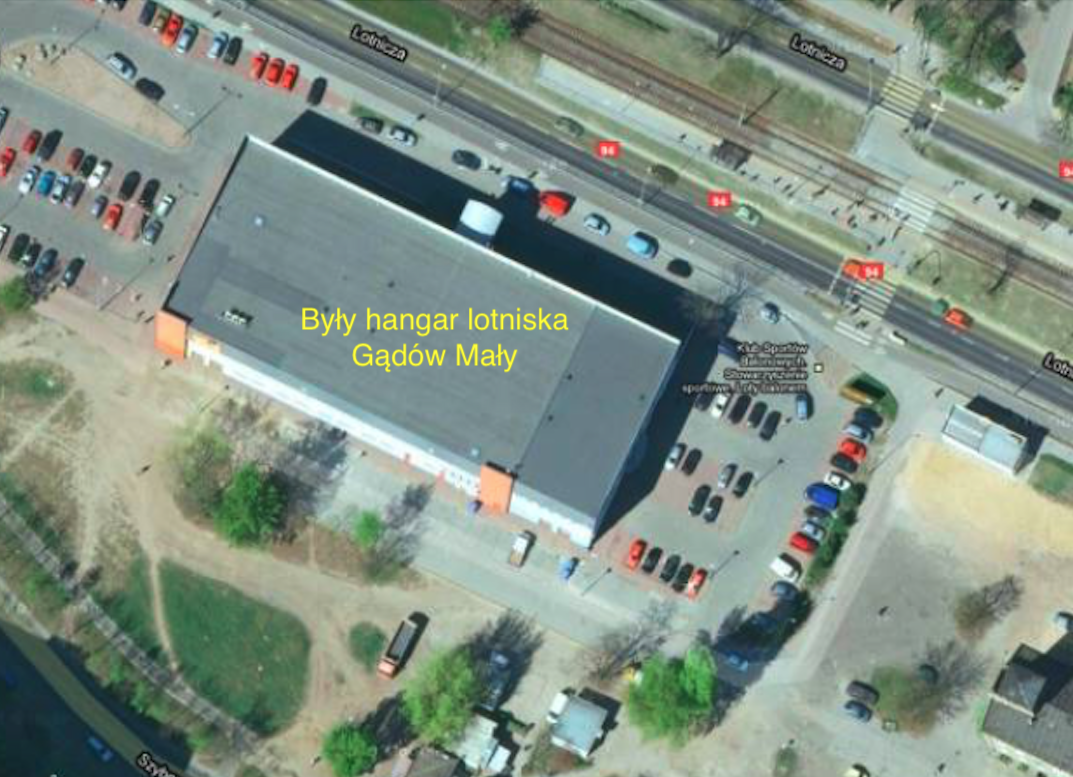Wrocław 2011-05-05
Former Gądów Mały Airport in Wrocław.
1910 – 1985.
Geographic coordinates: 51.129N 16.971E.
History.
The Gądów Mały airport was one of the airports in Wrocław. German name Flughafen Klein-Gandau. The airport played an important role, both in German hands and after World War II, when thanks to the greats of this world, it was in Polish hands. Currently (2011) the airport no longer exists, but the memory of it among aviation seniors is still alive. The more that many of them learned to fly at this airport.
The history of the Gądów Mały Airport began in the 19th century. On September 4, 1865, a multi-person balloon flight took place in Wrocław, organized by the Berg brothers. As reported by "Dziennik Poznański" – "The balloon having risen to a height of 6,000 feet safely returned to the ground near the village of Małe Gądowy".
In 1872, this area was bought by the Prussian army and after leveling it was used as an exercise and parade ground. Parades were held there. In 1906, there was a parade where Winston Churchill was a guest.
It is not known when this parade ground became an airport. Probably at the beginning a unit of observation balloons functioned here. It was one of the first airports in Germany and the only one in Wrocław, until the construction of the Srachowice Airport, located even further west of the center of Wrocław, began in 1936. The Gąd Mały airport had a good location. It was located on the main exit road from Wrocław towards the west. At a distance of 7 km from the city center. From 1926, the connection with the city center was provided by a tram line.
In 1910, a foldable, portable hangar for homing airships was erected at the airport. The airship Parseval PL-5 was stationed there, which burned down at Hann Münden during a hydrogen release on June 16, 1911. Its place was taken by the Parseval PL-9 airship, which in 1913 was sold to Turkey.
The first permanent infrastructure consisted of three hangars, probably built in 1914, just before the start of the great world war.
After the world war, from 1920, as a result of the provisions of the Treaty of Versailles, Germany was theoretically deprived of military aviation. The Gądów Mały airport remained exclusively civil. But it must be remembered that as a result of the unfading Soviet-German friendship, the latter were trained at the airports and training grounds of the Moscow state. A branch of the Junkers factory has been operating at the Gadów Mały Airport since 1922.
Presumably on January 31, 1926, at the eastern end of the landing field, near the street leading from the center of Wrocław, the first wooden airport station was opened. It was a one-story building with a gable roof, the base of which was 20 m x 10 m. The interior was illuminated with skylights. An observation tower was built on the roof. The building had its own boiler room. In 1927, clocks were installed on the building from the side of the street and from the landing field. The take-off field of the Gadów Mały airport was ground, but in place of the aircraft stands (on the platform apron) paved pavements were laid.
In 1929, on the other side of the landing field, in relation to the airport, three Junkers hangars were built.
After Hitler came to power, the Gad Mały Airport experienced a large increase in passenger traffic. Regular domestic flights to Berlin, Szczecin, Jelenia Góra, Gliwice, Goerlitz, Dresden, Leipzig and Halle were launched, as well as foreign flights to Warsaw and Prague. The airport was also a cover for the German army. Future pilots were trained here on gliding and parachute jumping courses. Challenge races in 1929 and 1930 ran through this airport. Airships visited the airport from time to time. In 1932, the first brick hangar with an air traffic control tower was built (at today’s Lotnicza Street).
In 1937, the modern (existing until today, 2022) building of the airport management was ceremonially put into use, with a new air traffic control tower, a representative arrivals hall and a restaurant on the observation deck. The building was designed by Ernst Pietrusky.
At that time, a bunker was built on the southern edge of the airport at ul. Bystrzycka and the driveway was concreted. But the airport had a soft, grassy surface throughout its existence. Even before the start of the Second World War, the Junkers factory began to build combat aircraft. Among others, Ju-88 Stukas. Both Wroclaw airports, just before the aggression of the German plague on the Republic of Poland, had dozens of combat aircraft in stock.
After the Republic of Poland lost the defensive war in 1939, Wrocław and its airports found themselves on the sidelines of the main warfare until, in January 1945, the Soviet front approached. When the ring around the Wrocław fortress closed, Gąd Mały Airport became the only transport route. In March 1945, heavy shelling destroyed the landing field, but paramilitary troops repaired the surface. At the end of March 1945, the front line moved to a distance of about 1 km from the airport. This made take-offs and landings practically impossible. Therefore, the airfield was used as a supply drop point. It is estimated that by that time the Germans had managed to evacuate over 6,000 wounded and bring in over 3,000 soldiers. On April 1, 1945, the airport was captured by the Soviets, but they did not move further towards the center. Let us remind you that Wrocław was not captured by the Soviets. After the disarmament talks, he surrendered on fair terms, which the Soviets did not keep.
War damage made it impossible to use the Gadów Mały Airport. The area was mined and there were many unexploded ordnance (duds). Demining and leveling the landing field lasted until 1947.
In the period 1946 – 1958, the Gądów Mały Airport served regular civil flights of the PLL LOT airline. The second airport, Srachowice Airport, was used exclusively by military aircraft, specifically by the Soviet army. At the same time, the Gądów Mały Airport in the period from the end of 1946 to 1978 was operated by the Aeroclub of Lower Silesia.
Photo description: Li-2 P aircraft No. 18439102, given name Duśka, initially had nb 05 on the fin.
A branch of Bielskie Zakłady Szybowcowe was established in the hangar at the Gadów Mały airport. By 1979, over 1,000 gliders of various types had been built. In 1958, a decision was made to transfer passenger transport from the Gądów Mały Airport to the Strachowice Military Airport. On September 13, 1959, the Air Show opened. 200,000 people gathered at the club’s airport for the inauguration. Passenger planes, military turbojet aircraft (PZL Lim-1), military helicopters (SM-1) and gliders were presented at the airport.
The airport was the center of the Wrocław aviation community. The first Air Raids of Journalists and Pilots took place here. International Competitions for the Blue Ribbon of the Oder River, Days of Wrocław Wings, etc. were organized in Gądów, among others; Aviation Training Centre, medical aviation, agricultural aviation, glider workshops, meteorological station. Mirosław Hermaszewski, a Polish cosmonaut, learned to fly here. In 1978, the last glider and parachute training was conducted and the airport was closed.
In the mid-1970s, the area of Gądów was designated for housing development and a decision was made to liquidate the airport. A housing estate was built in its place, and the names of the streets – Balonowa, Skrzydlata, Szybowcowa, Latawcowa, Sterowcowa, Klimatowa, and the boulevards: Dedala and Ikara – refer to the aviation past of this place. Finally, the airport disappeared from the maps in 1985. At that time, the construction of a residential estate consisting of blocks, with a large slab structure, was already well advanced and the "Astra" Department Store was opened at Horbaczewskiego Street.
Traces of the Gądów Mały Airport. 2011.
Hangar.
Photo description: The hangar from 1932, after numerous modifications, is now a grocery discount store. Aviation Street.
Port and airport management building.
The building still exists. Recently, the building was entered in the register of monuments. The building has been renovated. Inside, there are: Kindergarten No. 113 (Kindergarten Academy), the Reptile Housing Estate Council, the Police Station (previously a Municipal Guard facility) and apartments. Address: Lotnicza 22.
The air history of this place is reminded by the names of the streets and the monument unveiled in 2005, on the 60th anniversary of Polish Aviation in Wrocław and on the 95th anniversary of the creation of the Airport.
The third airport of Wrocław.
The third and last airport in Wrocław, which did not receive a name and infamously entered the history of the city, despite its short existence, was located between the Szczytnicki Bridge and the Grunwaldzki Bridge. The extensive field, which after the war gave rise to calling the entire area "the square", was created in the last weeks of World War II, during the siege of the Wrocław Fortress (Festung Breslau). After the Soviets seized the Gadów Mały Airport in April 1945 and the fortress lost the possibility of receiving supplies by air, the head of the NSDAP in Wrocław – Karl Hanke decided to "build" an airport inside the city. For this purpose, the representative, two-lane Kaiserstraße avenue (connecting the present Grunwaldzki Bridge with the Szczytnicki Bridge) was marked out and all buildings located along it were demolished: representative tenement houses and public buildings, including the Lutheran Evangelical Church. The "Scheitniger Stern" or "Szczytnicka Gwiazda" – a beautiful intersection with tenement houses in the place of the current Rondo Reagan – also ceased to exist. The hasty removal of rubble from the area of the future airport continued under the fire of Soviet planes and claimed numerous victims among the local civilian population and foreign workers forced to work. Probably only two planes took off from the "Karl Hanke airport": on April 10, 1945, Junkers Ju 52, which evacuated twenty-two wounded, and on the night before the surrender, on May 5, 1945, Fieseler-Storch 156, in which Karl Hanke escaped from Wrocław to Sudetenland (Kraj Sudety). Disputes about whether and when exactly this took place will probably not cease. After the war, for several years, Grunwaldzki Square turned into the largest marketplace in the city (szaberplac), because all kinds of property from abandoned German houses were traded here. Yes Germans – There was no need to start another world war, and you will pay compensation to Poland.
Written by Karol Placha Hetman

